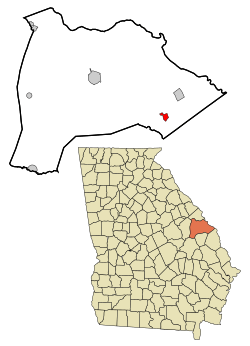Sardis, Georgia facts for kids
Quick facts for kids
Sardis, Georgia
|
||
|---|---|---|
|
||

Location in Burke County and the state of Georgia
|
||
| Country | United States | |
| State | Georgia | |
| County | Burke | |
| Area | ||
| • Total | 1.56 sq mi (4.05 km2) | |
| • Land | 1.55 sq mi (4.01 km2) | |
| • Water | 0.01 sq mi (0.04 km2) | |
| Elevation | 240 ft (73 m) | |
| Population
(2020)
|
||
| • Total | 995 | |
| • Density | 642.76/sq mi (248.13/km2) | |
| Time zone | UTC-5 (Eastern (EST)) | |
| • Summer (DST) | UTC-4 (EDT) | |
| ZIP code |
30456
|
|
| Area code(s) | 478 | |
| FIPS code | 13-68740 | |
| GNIS feature ID | 0322525 | |
Sardis is a city in Burke County, Georgia, United States. The population is 995 in 2020. It is part of the Augusta, Georgia metropolitan area in the Central Savannah River Area (CSRA).
Contents
History
Around the turn of the 20th century, a small crossroads community called Frog Wallow was developing in southeast Burke County. With the construction of the Savannah & Atlanta Railway, the tiny town lay on the new railroad connecting the two large hubs. In 1912, the town was incorporated as Sardis by the Georgia Legislature, named after the Baptist church that had flourished in the town over the past decades. The church's name, in turn, is a transfer from Sardis, an ancient city in present-day Turkey.
Sardis saw several decades of growth including a booming lumber industry. Then, in 1962, the owner of the railroad (Central of Georgia) abandoned the section of tracks between Waynesboro and Sylvania, which negatively affected the local economy. The tracks were subsequently removed in 1964. Sardis still retains its old train station and coal tower.
Geography
Sardis is located in southeastern Burke County at 32°58′28″N 81°45′31″W / 32.97444°N 81.75861°W (32.974510, -81.758504). It is 17 miles (27 km) southeast of Waynesboro, the Burke County seat.
According to the United States Census Bureau, the city has a total area of 1.5 square miles (4.0 km2), of which 0.015 square miles (0.04 km2), or 0.95%, is water.
Demographics
| Historical population | |||
|---|---|---|---|
| Census | Pop. | %± | |
| 1930 | 580 | — | |
| 1940 | 667 | 15.0% | |
| 1950 | 695 | 4.2% | |
| 1960 | 829 | 19.3% | |
| 1970 | 643 | −22.4% | |
| 1980 | 1,180 | 83.5% | |
| 1990 | 1,116 | −5.4% | |
| 2000 | 1,171 | 4.9% | |
| 2010 | 999 | −14.7% | |
| 2020 | 995 | −0.4% | |
| U.S. Decennial Census 1850-1870 1870-1880 1890-1910 1920-1930 1940 1950 1960 1970 1980 1990 2000 2010 |
|||
| Race | Num. | Perc. |
|---|---|---|
| White (non-Hispanic) | 469 | 47.14% |
| Black or African American (non-Hispanic) | 436 | 43.82% |
| Native American | 3 | 0.3% |
| Asian | 1 | 0.1% |
| Other/Mixed | 74 | 7.44% |
| Hispanic or Latino | 12 | 1.21% |
As of the 2020 United States census, there were 995 people, 328 households, and 198 families residing in the city.
See also
 In Spanish: Sardis (Georgia) para niños
In Spanish: Sardis (Georgia) para niños



